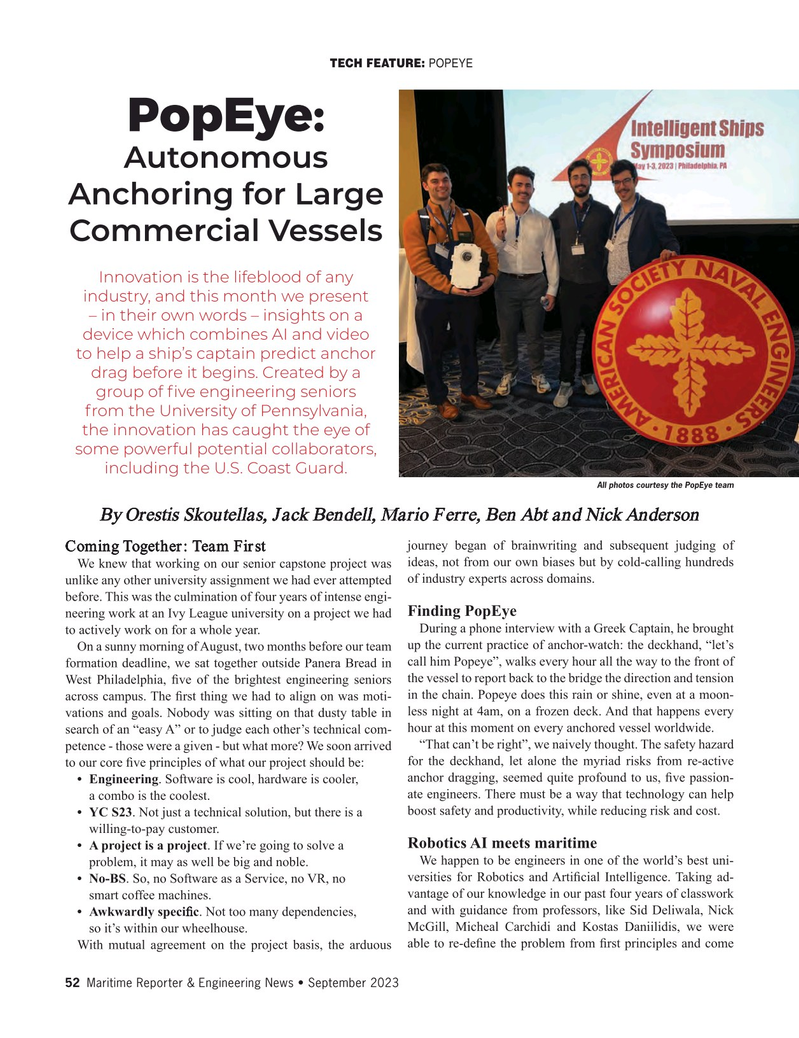
Page 52: of Maritime Reporter Magazine (September 2023)
Marine Design Edition
Read this page in Pdf, Flash or Html5 edition of September 2023 Maritime Reporter Magazine
TECH FEATURE: POPEYE
PopEye:
Autonomous
Anchoring for Large
Commercial Vessels
Innovation is the lifeblood of any industry, and this month we present – in their own words – insights on a device which combines AI and video to help a ship’s captain predict anchor drag before it begins. Created by a group of ? ve engineering seniors from the University of Pennsylvania, the innovation has caught the eye of some powerful potential collaborators, including the U.S. Coast Guard.
All photos courtesy the PopEye team
By Orestis Skoutellas, Jack Bendell, Mario Ferre, Ben Abt and Nick Anderson journey began of brainwriting and subsequent judging of
Coming Together: Team First
We knew that working on our senior capstone project was ideas, not from our own biases but by cold-calling hundreds unlike any other university assignment we had ever attempted of industry experts across domains.
before. This was the culmination of four years of intense engi-
Finding PopEye neering work at an Ivy League university on a project we had
During a phone interview with a Greek Captain, he brought to actively work on for a whole year.
On a sunny morning of August, two months before our team up the current practice of anchor-watch: the deckhand, “let’s formation deadline, we sat together outside Panera Bread in call him Popeye”, walks every hour all the way to the front of
West Philadelphia, ? ve of the brightest engineering seniors the vessel to report back to the bridge the direction and tension in the chain. Popeye does this rain or shine, even at a moon- across campus. The ? rst thing we had to align on was moti- vations and goals. Nobody was sitting on that dusty table in less night at 4am, on a frozen deck. And that happens every hour at this moment on every anchored vessel worldwide.
search of an “easy A” or to judge each other’s technical com- “That can’t be right”, we naively thought. The safety hazard petence - those were a given - but what more? We soon arrived for the deckhand, let alone the myriad risks from re-active to our core ? ve principles of what our project should be: anchor dragging, seemed quite profound to us, ? ve passion- • Engineering. Software is cool, hardware is cooler, ate engineers. There must be a way that technology can help a combo is the coolest.
boost safety and productivity, while reducing risk and cost.
• YC S23. Not just a technical solution, but there is a willing-to-pay customer.
Robotics AI meets maritime • A project is a project. If we’re going to solve a
We happen to be engineers in one of the world’s best uni- problem, it may as well be big and noble.
versities for Robotics and Arti? cial Intelligence. Taking ad- • No-BS. So, no Software as a Service, no VR, no vantage of our knowledge in our past four years of classwork smart coffee machines.
and with guidance from professors, like Sid Deliwala, Nick • Awkwardly speci? c. Not too many dependencies,
McGill, Micheal Carchidi and Kostas Daniilidis, we were so it’s within our wheelhouse.
With mutual agreement on the project basis, the arduous able to re-de? ne the problem from ? rst principles and come 52 Maritime Reporter & Engineering News • September 2023
MR #9 (50-60).indd 52 9/6/2023 6:44:07 PM

 51
51

 53
53
